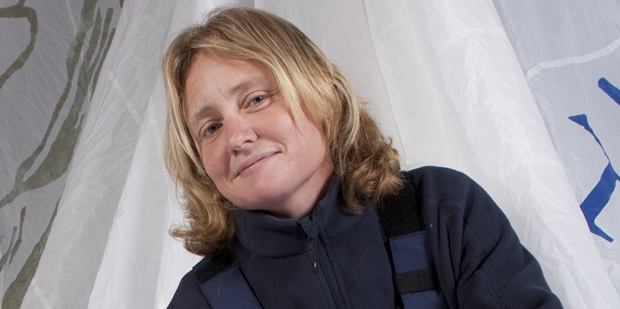
Mini Transat and/or bust
Five months out from the start of the Mini Transat is always a tense time for potential competitors who have yet to qualify. As ever the singlehanded transatlantic for the pint-sized ocean racers is over-subscribed and for those without a confirmed entry a large question mark remains over whether they will be among the maximum number of 72 boats allowed on to the start line come 25 September.
A handful of Brits are gunning for this year’s race. Of these to date only Lymington-based Dan Dytch on the Proto Ocean Watch has been confirmed. At present on the waiting list are Pip Hare and Piers Dudin and they are supposed to be being joined by Becky Scott on the Artemis Offshore Academy’s Pogo 2, previously campaigned by Ollie Bond.
Of these one of the most impressive, in terms of her understated, but otherwise steely determination to make it, is Pip Hare.
While the majority of Mini sailors get into the class during their 20s as the first rung of the solo offshore racing ladder, Hare has followed other past Mini sailors such as 2007 entries Andrew Wood and David Rawlinson in coming from a background in the marine industry.
37 years old, Hare has spent her working life employed on sailing boats as far as afield as the Caribbean and New Zealand either as skipper or coaching or on deliveries. “After I left school I went to work in the sailing industry. I got my YachtMaster Commercial endorsement and have been working as a professional skipper since then.” She heralds from Cambridgeshire and learned to sail on the River Deben, where her family is still based.
However her experience isn’t limited to big boats. In the late 1990s, the heyday of the Laser skiffs, she was a 5000 sailor. “I remember seeing the 5000 during my last year at school and thinking it was the coolest boat, so I did that for four years.”
Prior to getting into solo offshore racing, Hare was divided her life between work and cruising around the world on her home for the last eight years - a Lightwave 395 called The Shed. “I have done loads and loads of miles cruising in The Shed doublehanded and it was something I always wanted to do, because, thinking about the skill set that I have, I don’t have a particular high skill level in one thing, but I know boats, I know how to look after them and maintain them and do all the miles, keep going, etc,” she says. “I guess I am a jack of all trades and a master of none, but I think for the long distance solo stuff that suits me better. I wanted to have a go at being good at something, so that seemed to be the right thing for me. Plus bizarrely I love being at sea on my own...”
While she remembers wanting to do the Mini in her 20s, then it was too big a hurdle. As she puts it –the biggest step is converting from saying ‘I want to do it’ to ‘I am going to do it’.
The catalyst that finally propelled her into the sport was when Cazenove Capital Management, with whom she had been corporate sailing at Cowes Week in 2008, said they would help her with funding. She then looked around at what she could do and the 2009 OSTAR was perfect as she could do it in The Shed.
“It has done a lot of miles that boat,” she says of her beloved Lightwave. “I was cruising down in South America when they offered me that, so I sailed back singlehanded from Uruguay to the UK to get the boat back to refit it, to do the OSTAR. That year I did about 13,000 miles probably...” In total she reckons she has more than 80,000 miles under her belt having sailed down to New Zealand, across the Tasman, down to Patagonia plus various transatlantics, 12,000 or so miles solo.
The long delivery back up the Atlantic proved invaluable. “That took 58 days and was good for me, because a lot of people when they go into their first solo race they don’t know what it is like to be on your own for that long, but I’d done that bit. So the OSTAR for me became a test to see how far I could push myself and how daring I was going to be.”
In the OSTAR, The Shed suffered broke a lower and Hare had to put into Southern Ireland to fix it. Despite the delay, The Shed returned to the race course and ended up arriving in Newport, RI 15th overall.
With the OSTAR under her belt Hare says she was considering the Class 40 until she ended up going on a Keelboat Coaching course with some illustrious colleagues such as Brian Thompson, Paul Peggs and Tim Tiberon. Thompson and Peggs, both former Mini competitors and enthusiastic supporters of the class, encouraged her in that direction.
“They felt that the Mini was a stepping stone,” she says. “I particularly wanted to up my sailing skill level and my technical knowledge and the Mini is such a different boat from anything I am used to sailing.”
The Figaro would have been an alternative and having since spent time with Figaro sailors, Hare says she made the right decision. “In the Figaro they are into gaining every inch they possibly can, racing a boatlength apart. It is very intense and very close, but their races are [usually] a lot shorter than a Transat and a Transat requires different strategy and I guess that is more what I am used to. I guess the next step would be the Figaro because that would up my game again. There is also an funding issue because the Figaro is so French and even though the Mini is also French it can inspire people because they look at it and say ‘that is a really small boat – that is really stupid!' It is something that everyone can understand.”
Having established the Mini as being the way forward, she then had to buy a boat. She decided upon a ‘Series’ Mini, rather than the ‘Proto’ because she admits she is “not a tweaker. I just need to work on my sailing and if there are too many things to change around me, I won’t focus on the sailing.”
In deciding upon which type of Series boat to go with, Mini sailor Keith Willis came to the rescue talking her out of a Dingo or a Ginto and into the Series class’ most popular sub-set, the Finot-Conq designed Pogo 2. “Keith was amazingly helpful. He is a big Mini nerd. He loves them. So any advice – he will talk for hours on it. But most people I have come across who have been involved with the Mini, they are all very free with advice.”
Two months after her Keelboat Coaching course, in April last year, Hare had acquired a virtually new and unraced Pogo 2 (hull # 743), built in 2007 for a Belgium owner. This was christened The Potting Shed.
However last summer the focus was on the Royal Western YC’s doublehanded Shetland Round Britain and Ireland Race, which she sailed on her cruiser racer home The Shed with Phil Stubbs. In this they were leading IRC 3, with a 15 hour margin on the second boat when they left Lowestoft, although by the finish this had evaporated to five hours in the fickle winds of the Channel during that period.
As a result it wasn’t until October that she got to sail the Pogo2 in earnest. Having never been raced the boat needed a lot of preparing for race readiness. She toured the French Pogo2 strongholds of Douarnannez and Lorient armed with her camera to see the tweaks her competitors had made.
“I have been quite careful in how I’ve set it up. I haven’t just gone in and done what everyone else has done and I’ve done some things differently to suit me. For example loads of people have got the main sheet coming off the traveller along the boom and then they’ve got a central swivel cleat, which initially I thought was a great idea, but I have a fantastic open cockpit which is great for gybing and moving around the boat, I can sleep really easily in it so I have just played around with where it is on my traveller and left it there.”
Another feature of Hare’s autumn was participating in the Artemis Offshore Academy trials and while ultimately she wasn’t selected for the squad she remains an associate member and over the winter made use of the coaching at Franck Citeau’s Centre d’Entrainment (CEM) in La Grande Motte.
“Going to CEM has been absolutely amazing,” she says. “I have never experienced anything like it but I can’t tell you how strung out I am because I am self employed I have to keep things going and it is backwards and forwards. Where do your loyalties lie? I really want to make an effort with this campaign so I have to put everything into that, but I can’t just shut off life in the UK because otherwise when I get back there won’t be anything left.”
The training facility in La Grande Motte is principally for the Figaro, but over the course of her stay Artemis Offshore Academy Mini sailor Becky Scott was also there and occasionally there would be as many as eight Minis. However their requirements slightly differed from her own. “I did the whole of December on the water, pretty much every day - which is what I really needed, jumping in the deep end. But because the Minis there are all on two year campaigns and they have all qualified already, they are all far more familiar with the boats. And for all of them it will be their first transatlantic. Through January there was a lot of theory about navigation and I have done all that already and the level they were learning at, was the level I usually teach it. But it helped with my French!”
From here the major issue is getting qualified and then fully accepted as an entry in the Mini Transat. Pip sailed her mandatory 1000 miles on the course in the Mediterranean as laid out by the Classe Mini. This took her from La Grande Motte across to Italy, back towards Barcelona and then to La Grande Motte. This she covered in 8 days and one hour, a time she later found out was close to the record, having spent much of the westbound leg blasting downwind in 35 knots occasionally gusting to 40.
“I had never done any sailing like that ever. With the qualifiers, you are allowed to stop if the weather is bad because the weather in the Med is so changeable and if it is the Mistral it is vicious but I didn’t stop because I wanted to see what it was like!”
Following the qualifier, Pip competed in the Arcipelago Race in Italy, where she finished third in the Series class and then in the Grand Prix d’Italie, which at 540 miles ticked another box in the Mini qualification in requiring competitors to have taken part in a race of more than 500 miles. She has since headed for France to compete in this week’s Pornichet Select which should see the end of her qualification requirements for the Transat, although she remains on the waiting list... “I speak to Classe Mini every week. They think people are going to drop out. I don’t think you can go into it with any other thought than that you are going to make it. I knew it was going to be a tall order to run a year-long campaign.”
As to how she is taking to solo sailing she says there are a couple of things in particular she has learned. “I realised when I was sailing Shed, that I need to know that my boat isn’t going to break up around me and the Pogo is absolutely solid. And I have a thing about rigs – I need to know that I have set my rig up properly and it’s not going to fall down if I gybe, etc. So I’ve spent a lot of time setting up my rig and talking to people about it, putting it back on, looking at it, etc. And going through that much breeze and those waves [on the 1000 mile qualifier], I have come out of it being so comfortable with the boat and now I feel I can do other stuff. There is no pre-occupation there.”
Otherwise she says she has found it hard to turn off. “Because it is so small you can feel everything when it is not right. So you say ‘right, I have got to sleep now’, so you let the pilot drive and you set the boat up and you can just feel it is not right and that is really hard, because it really gets to you so I am going to have to learn to live with that.”
However aside from this, Pip seems to have something of a natural disposition towards solo racing. “The 1000 miler was the first time I had done anything big since the OSTAR and I just dropped straight into taking 10-15 minute naps no problem at all. I am very comfortable on my own and I just like being able to sort it out myself and I like pushing myself and I like getting it right and dealing with it if I get it wrong. It suits me and it suits my character.”
From here, Pip plans to compete in the Royal Western YC’s UK Mini Fastnet starting on 15 May and also hopes to be the French Mini Fastnet too on 19 June. Her exact program depends upon funding. “It is about trying to find the balance. I am still trying to find a sponsor. If I can make that work then I won’t have to work as much. I am looking for £40,000 to get to the line but it is a sliding scale...”
Buying the Pogo cost £40,000 and she is racking up debt on credit cards. As she justifies it: “Are you just going to sit around wishing that money is going to fall out of the sky or make it work and deal with it afterwards. I can afford to do the Transat now. I am looking at everything I have and at the end of the Transat I should be able to cover all of my bills but I’ll be down to zero, that involves spending my life’s savings. But I am definitely prepared to do that.”
Her ultimate dream is to get an IMOCA 60 and compete in the Vendee Globe, but a more realistic place to move after the Mini will into the Class 40 with the goal of the Solo Global Ocean Race in 2013, perhaps using a Figaro to train in down in La Grande Motte during 2012 and competing in the Artemis Transat.

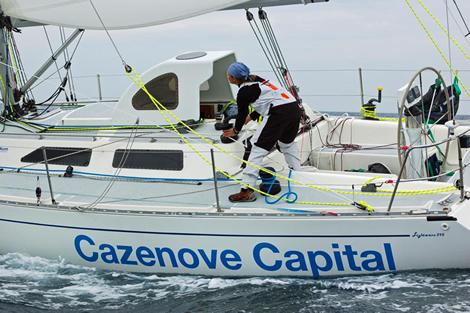
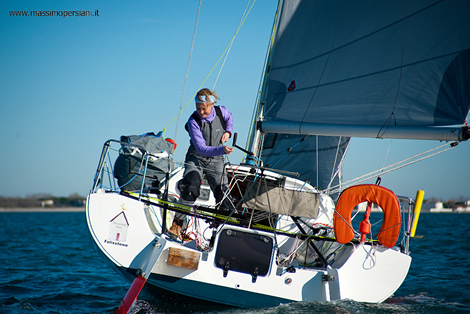
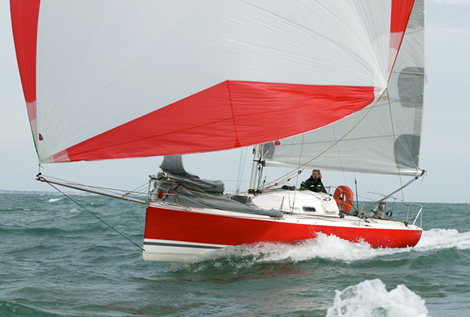
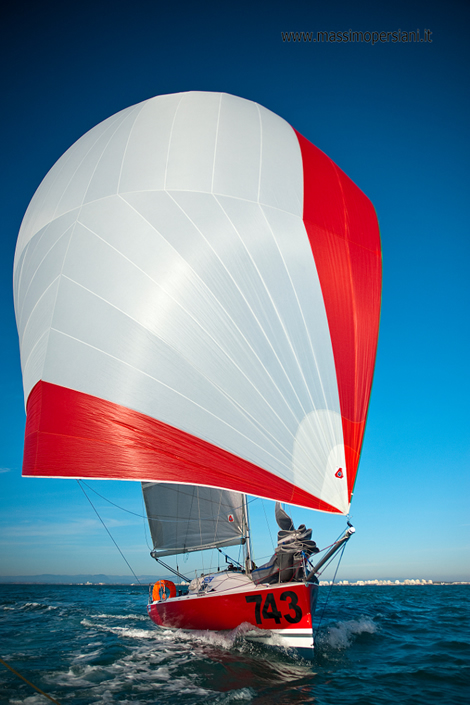








Latest Comments
Add a comment - Members log in